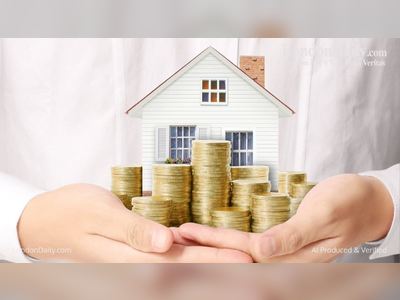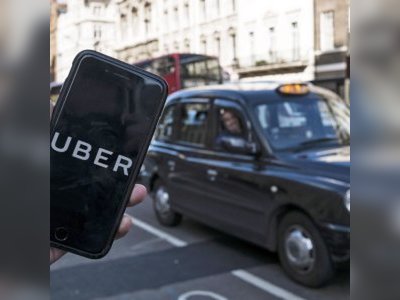
The Pandemic Destroyed My Personal Style, And I’m Not Alone
“Can I wear this for 12+ episodes on Netflix while eating Taco Bell? Would I be upset if it got stained?”
I put on a dress the other day. I felt like a lizard person trying to persuade the humans of Earth that I was one of them. The feeling of the stiff fabric pulling taut over my bigger, pandemic-era body, the weirdness of seeing myself wearing something I hadn’t worn for over a year — just that simple act felt wildly unfamiliar.
It wasn’t that long ago that figuring out what to wear was one of the most affirming and delightful parts of my day. Which designers did I love? What silhouettes suited me best? What was I really saying about myself with that onesie? Outfits were practical quotidian necessities, yes, but also a way to visually express who I was (a slob, but fun) and what mattered to me (room around the waist in case of a second dinner).
But being at home for an extended period as COVID-19 trampled all over my routines, health, and giving-a-shit quotient changed that. There were other, more pressing things to think about — like health, employment, and money. The pandemic is a crucible that has applied pressure on every single one of them. So scouring online stores and thinking about silk dresses fell by the wayside as I stayed home, perceived by nobody.
As summer approaches, though, and more people get vaccinated in New York, where I live, the city is reopening. Some “back to normal” stuff is relatively easy to figure out. What do I feel comfortable doing? Outdoor gatherings and 1:1 indoor hangs with vaccinated pals. Where am I OK with going? Parks and patios. The question of what I should wear, though? Literally no idea. Past Me was very into getting dressed. Present Me would like to live in sweatshirt material forever.
When we recently asked BuzzFeed News readers if their style had changed because of the pandemic, I realized I was far from alone in my confusion. “I no longer know how to dress for anything,” said Hayley Malkus, a 26-year-old from Baltimore who works in property management. “I spent all of spring not knowing what to wear since I didn’t have to get dressed last year for the office.”
Many respondents shared my enthusiasm for sweatpants, which is no surprise: In 2020, sales of sweatpants increased by 17% nationally, as employment fell and some jobs became remote. Denise Wight, a 32-year-old technician from Longmont, Colorado, said she developed something of a sweatpant habit. “I believe I owned two pairs prior to the pandemic,” she said. “I now have 10.” Rachael Haas, a 33-year-old copy editor from Cleveland, is also relying heavily on sweatpants now that she works from home. “I developed a chronic back pain issue right around the start of quarantine (no coincidence, sadly) that makes tight-fitting garments really uncomfortable,” she said. “I like to change into my ‘comfies’ when I get home from work. But now, there is no ‘getting home from work,’ just ‘walking out of the room I work in and into the rest of my home.’ So I wear a lot more sweatpants and hoodies than usual.” (Then there are people who completely leaned into pajamas. “I look put together on video calls but I'm so comfy in my PJs bottoms,” said Amy Cusden, a 27-year-old publisher from Oxford, England.)
Sweats have become staples; leggings, their athleisure counterpart, even more so. Remember when people used to debate whether leggings counted as pants? No longer an issue. Several respondents cited them as a favored work-from-home option, pairing them with roomy tunics and sweaters. After all, on Zoom, nobody can see your bottom half. But even in a physical office, they’re becoming more acceptable. “Pants are all but nonexistent in my wardrobe now,” said Laura McGee, a 25-year-old librarian from Baltimore. “I went to work in a pair of what look like actual pants but are definitely just leggings, and my supervisor, who's worked with me for at least a year now, asked, ‘Pants? What's the occasion?’”
Having welcomed soft pants into our lives, it seems people have overwhelmingly farewelled the “hard” variety: jeans. “I've pretty much stopped wearing anything that is confining and constricting,” said Sarah, a 29-year-old nonprofit employee from Madison and one of several respondents who asked we withhold their last name. “Jeans? Only my oldest pair, which have been so broken in they're pretty comfy by this point. But my high- waisted skinny jeans? No way.” Maggie W., from Toronto, puts them in a “too hard” category, along with dresses and heels: “Anything that involves some effort,” she said. “What's the point? No one at Costco is going to appreciate my lewk.”
Many respondents were glad to be rid of business casual clothing now that fewer people are going to the office. Joe Liner, who lives in Brooklyn, has transitioned from basic button-ups — “I basically just looked like a Uniqlo drone in the worst way” — to fully embracing prints. “I love patterned shirts, so I have a massive collection that only got to shine on the weekends. ... Now I can wear them every day!” Shoes, too, have become less relevant to those of us staying at home; plenty of people who wrote to us reported that their high-heeled shoes were gathering dust, in favor of Birkenstocks, Crocs, and sneakers.
As my colleague Tomi Obaro predicted, there was one other notable loser: bras. “At first I was like, ‘No underwire for me,’ and tried so many little crop top–style things,” said Kate Leaver, a 33-year-old author from London. “They were simply a gateway to letting my boobs be free. Now I honestly do not want to wear a bra ever again, unless specifically required for logistics or professionalism.” Kristina Batkovska, a 28-year-old project manager who lives in Sydney, has declared bras her “enemy.” “My boobs refuse to be in the prison ever again,” she said. “Seriously, the other day I wore a bra for 12 hours and by the end I was in pain.”
Our embrace of sweats and aversion to underwires and denim are part of a bigger pattern. Comfort reigns these days, in large part because the former pressures of dressing “appropriately” for different contexts — and for other people — have dwindled. A 36-year-old assistant project manager from Texas, who asked that her real name not be used, has developed some new criteria for deciding what to buy and wear. “Can I wear this for 12+ episodes on Netflix while eating Taco Bell?” she said. “Would I be upset if it got stained? Can I wear this outside and still be comfortable?”
With many people losing their jobs over the past year, strained budgets have also been a concern. “I don’t spend money on clothes anymore,” said Lucinda Miller, a 43-year-old from Seattle who works in administration and accounting. “It is more important to me to put my money in savings because I want to feel secure and not worried about being unemployed or homeless because I am broke.” Rachel Gardner, a 26-year-old environmental engineer from Warrensburg, New York, said the pandemic was a wakeup-call about her needless consumption of new clothes. “By wearing only 5% of my wardrobe, I’m seeing firsthand how much money I’ve spent through the years on shoes and dresses and skirts and coats, and now it just seems wasteful since they’re not pieces I would wear on a frequent basis,” she said.
We’re also able to get more casual in our daily dress because, well, nobody is around to see us. “I used to care more about how my outfits looked and how I could appear put together for other people,” said Holly, a 25-year-old from New Mexico. “During the pandemic, most of the time I was completely alone. No one cared what I was wearing and I didn’t feel the need to put in any effort. I’m immune suppressed and lost my job right when the shutdown hit. There was no reason for me to look put together in any sense, so I didn’t.” Still, she regrets having played it safe in the past with her style. “I do not want to wait for a certain event or reason to wear things I want to wear,” she said. “I just want to feel good about myself when I get dressed.”
Plenty of people found their bodies changing over the course of the past year. Jokes about the “quarantine 15” became commonplace (as did the cycle of moralizing, body-shaming, and anxiety that generally accompanies any public conversation about weight) as stress from a global pandemic triggered different eating habits. This change to our bodies often also meant a change in what we wore. Victoria Miller, a 22-year-old who works at a community college in Illinois, said that, like many others, she gained weight. “I found myself wearing comfy clothing like sweats and oversized T-shirts,” she said. “That was fun for a while, but I noticed that it made me feel bad about myself. I was already moping around because of my new belly, but I was making things worse by dressing down. Lately, I've been embracing my new body and am starting to wear a lot more color! I dyed my hair pink and love wearing eye-catching and sometimes crazy pieces.”
Shekina Roberts, a 23-year-old student and nanny from Atlanta, said she got “quarantine thick,” which caused her opinions — and wardrobe — to shift. “I had to throw my whole closet away,” she said. “Fashion was important to me before because I felt like you really need this manicured image to feel good about how you look, and you really don’t. I feel sexy in this oversized Goosebumps T-shirt.”
While some have found the past year a welcome break from sartorial norms, others miss the social, creative aspect of personal style. “I still find myself in a style slump and have no idea what to wear,” said Adriana Figueroa, a 32-year-old engineer from Ventura, California. “I think the lack of going into an office and getting inspiration from other people’s outfits is a factor, along with feeling like most outings are filled with an amount of anxiety and no longer an event to dress up for.”
Often, what used to be an enjoyable daily task is now a drag. Occupational therapist Lyndsie, 30, from Ohio, used to want to work in the fashion industry and found putting outfits together a source of happiness. That has changed significantly. “Honestly, I’m just struggling to find what brings me joy with clothes,” she said. “I don’t feel nearly as excited to dress up or put together outfits like I once did. ... There’s so much more happening in the world that what I put on my body doesn’t seem quite as important.”
Others find it stress-inducing. “I peruse Pinterest and shopping sites for hours for ideas for new outfits and then nothing I wear is ever good enough,” said Jen Thompson, 31, of Oklahoma City. “It’s like I forgot how to be confident in myself outside of my home, in public. … I get so much anxiety about what to wear going on a date, to the store, to grab a drink or dinner.”
It’s no surprise that at a time of such uncertainty, people are having trouble engaging with an activity that might feel trivial. Yet even if it’s a relatively small loss, it’s still something that Elizabeth LePage, a 32-year-old photographer from Portland, Oregon, mourns. “Clothing felt transformative to me before the pandemic. It was a world that I could enter with joyful abandon,” she said. “I could be a cool girl, with slick shades and an easy look. I could be a vintage queen, with a sweetheart neckline and kitten heels. I could gender swap and wear men’s clothes. Now, clothing feels like a chore. … I miss my old feelings about clothes and I can’t seem to find them again.”
Conversely, that persona-enhancing quality of clothing has actually helped a few people maintain a sense of normalcy throughout the pandemic. Alissa Krohn, a 20-year-old student from St. Paul, Minnesota, has been taking online classes from home. “I found that it was helpful to still get dressed every morning to help maintain some form of a routine,” she said. “I started getting more dressed up for the few times that I did have to leave the house. ... I've also found that putting together an outfit that I really like can make the day just a bit better.” With restrictions limiting many of our activities, fashion was a welcome respite for 19-year-old Lily Fox, a student from Phoenix. “I was what any reasonable person would consider incredibly basic before the pandemic,” she said. “Now, I feel like my clothes are one of the only forms of self-expression available to me during quarantine, so I’ve really honed my personal style and am more confident for it.”
A couple of people, including 24-year-old graduate student Allison Bailey, who lives in New Haven, Connecticut, have relished the opportunity to rethink their approach to fashion. “I finally had the time to go through my closet Marie Kondo–style and get rid of clothes that didn’t suit me anymore,” she said. “I realized I was holding on to a lot of high-end pieces because I liked the label, even though the pieces themselves weren’t comfortable or didn’t fit right. What’s left is a closet full of clothes I feel happy and confident in.” Angela-Frances Ibhade, a student and tutor living in St. Catharines, Canada, has cast off gendered expectations about what to wear. “Most of my outfits were catered to the male gaze because that’s all I knew growing up in Nigeria,” she said. “Then quarantine happened and I gained some weight. Suddenly, I hated the thought of skinny jeans and I found myself giving away my tight crop tops.”
Whether we’re excited and impatient to get dressed up again or hugely over it, the enforced pause has highlighted the issue of sustainability for several people. “I think more about being sustainable and wearing what I already have and shopping secondhand,” said Amanda Ayres, a digital PR executive who lives in Gateshead, UK. Caitlin Sheldon, a 35-year-old librarian from upstate New York, hopes “others also become more thoughtful and deliberate about their clothing buying habits. The people who make our clothes deserve a living wage, and we all deserve a clean, healthy Earth, and I'm hoping the pandemic has given people the time and space to think about that.”
Frankly, it was a relief knowing that others were struggling with this part of their lives. We’re all experiencing a push-and-pull between our past and future selves, not knowing how to account for the enormous changes we’ve undergone. Having lost the fluency with which I once eyeballed my closet and sifted through thrift stores, relishing the opportunity to remake myself every day, feels like having lost some vital part of myself, like my name. How can I tell you who I am without my sense of style? But I’m also hoping it’s an opportunity to reconsider my relationship with personal style, spending, and the fashion industry. Can I take advantage of the freedom that comes from changing priorities and expectations, at least when it comes to this not-so-serious subject? I think so, especially if I want to take my cues from those who still find pleasure in it.
“The other day I worked in my garden in a floor-length tulle skirt that has a city skyline embroidered on it, and gave no fucks at my neighbors’ odd glances,” said Michelle Roque, a 28-year-old retail manager from Augusta, Georgia. “Wear the dress. Put on the shoes. Who cares if you’re only watching Netflix? Do the thing.”
It wasn’t that long ago that figuring out what to wear was one of the most affirming and delightful parts of my day. Which designers did I love? What silhouettes suited me best? What was I really saying about myself with that onesie? Outfits were practical quotidian necessities, yes, but also a way to visually express who I was (a slob, but fun) and what mattered to me (room around the waist in case of a second dinner).
But being at home for an extended period as COVID-19 trampled all over my routines, health, and giving-a-shit quotient changed that. There were other, more pressing things to think about — like health, employment, and money. The pandemic is a crucible that has applied pressure on every single one of them. So scouring online stores and thinking about silk dresses fell by the wayside as I stayed home, perceived by nobody.
As summer approaches, though, and more people get vaccinated in New York, where I live, the city is reopening. Some “back to normal” stuff is relatively easy to figure out. What do I feel comfortable doing? Outdoor gatherings and 1:1 indoor hangs with vaccinated pals. Where am I OK with going? Parks and patios. The question of what I should wear, though? Literally no idea. Past Me was very into getting dressed. Present Me would like to live in sweatshirt material forever.
When we recently asked BuzzFeed News readers if their style had changed because of the pandemic, I realized I was far from alone in my confusion. “I no longer know how to dress for anything,” said Hayley Malkus, a 26-year-old from Baltimore who works in property management. “I spent all of spring not knowing what to wear since I didn’t have to get dressed last year for the office.”
Many respondents shared my enthusiasm for sweatpants, which is no surprise: In 2020, sales of sweatpants increased by 17% nationally, as employment fell and some jobs became remote. Denise Wight, a 32-year-old technician from Longmont, Colorado, said she developed something of a sweatpant habit. “I believe I owned two pairs prior to the pandemic,” she said. “I now have 10.” Rachael Haas, a 33-year-old copy editor from Cleveland, is also relying heavily on sweatpants now that she works from home. “I developed a chronic back pain issue right around the start of quarantine (no coincidence, sadly) that makes tight-fitting garments really uncomfortable,” she said. “I like to change into my ‘comfies’ when I get home from work. But now, there is no ‘getting home from work,’ just ‘walking out of the room I work in and into the rest of my home.’ So I wear a lot more sweatpants and hoodies than usual.” (Then there are people who completely leaned into pajamas. “I look put together on video calls but I'm so comfy in my PJs bottoms,” said Amy Cusden, a 27-year-old publisher from Oxford, England.)
Sweats have become staples; leggings, their athleisure counterpart, even more so. Remember when people used to debate whether leggings counted as pants? No longer an issue. Several respondents cited them as a favored work-from-home option, pairing them with roomy tunics and sweaters. After all, on Zoom, nobody can see your bottom half. But even in a physical office, they’re becoming more acceptable. “Pants are all but nonexistent in my wardrobe now,” said Laura McGee, a 25-year-old librarian from Baltimore. “I went to work in a pair of what look like actual pants but are definitely just leggings, and my supervisor, who's worked with me for at least a year now, asked, ‘Pants? What's the occasion?’”
Having welcomed soft pants into our lives, it seems people have overwhelmingly farewelled the “hard” variety: jeans. “I've pretty much stopped wearing anything that is confining and constricting,” said Sarah, a 29-year-old nonprofit employee from Madison and one of several respondents who asked we withhold their last name. “Jeans? Only my oldest pair, which have been so broken in they're pretty comfy by this point. But my high- waisted skinny jeans? No way.” Maggie W., from Toronto, puts them in a “too hard” category, along with dresses and heels: “Anything that involves some effort,” she said. “What's the point? No one at Costco is going to appreciate my lewk.”
Many respondents were glad to be rid of business casual clothing now that fewer people are going to the office. Joe Liner, who lives in Brooklyn, has transitioned from basic button-ups — “I basically just looked like a Uniqlo drone in the worst way” — to fully embracing prints. “I love patterned shirts, so I have a massive collection that only got to shine on the weekends. ... Now I can wear them every day!” Shoes, too, have become less relevant to those of us staying at home; plenty of people who wrote to us reported that their high-heeled shoes were gathering dust, in favor of Birkenstocks, Crocs, and sneakers.
As my colleague Tomi Obaro predicted, there was one other notable loser: bras. “At first I was like, ‘No underwire for me,’ and tried so many little crop top–style things,” said Kate Leaver, a 33-year-old author from London. “They were simply a gateway to letting my boobs be free. Now I honestly do not want to wear a bra ever again, unless specifically required for logistics or professionalism.” Kristina Batkovska, a 28-year-old project manager who lives in Sydney, has declared bras her “enemy.” “My boobs refuse to be in the prison ever again,” she said. “Seriously, the other day I wore a bra for 12 hours and by the end I was in pain.”
Our embrace of sweats and aversion to underwires and denim are part of a bigger pattern. Comfort reigns these days, in large part because the former pressures of dressing “appropriately” for different contexts — and for other people — have dwindled. A 36-year-old assistant project manager from Texas, who asked that her real name not be used, has developed some new criteria for deciding what to buy and wear. “Can I wear this for 12+ episodes on Netflix while eating Taco Bell?” she said. “Would I be upset if it got stained? Can I wear this outside and still be comfortable?”
With many people losing their jobs over the past year, strained budgets have also been a concern. “I don’t spend money on clothes anymore,” said Lucinda Miller, a 43-year-old from Seattle who works in administration and accounting. “It is more important to me to put my money in savings because I want to feel secure and not worried about being unemployed or homeless because I am broke.” Rachel Gardner, a 26-year-old environmental engineer from Warrensburg, New York, said the pandemic was a wakeup-call about her needless consumption of new clothes. “By wearing only 5% of my wardrobe, I’m seeing firsthand how much money I’ve spent through the years on shoes and dresses and skirts and coats, and now it just seems wasteful since they’re not pieces I would wear on a frequent basis,” she said.
We’re also able to get more casual in our daily dress because, well, nobody is around to see us. “I used to care more about how my outfits looked and how I could appear put together for other people,” said Holly, a 25-year-old from New Mexico. “During the pandemic, most of the time I was completely alone. No one cared what I was wearing and I didn’t feel the need to put in any effort. I’m immune suppressed and lost my job right when the shutdown hit. There was no reason for me to look put together in any sense, so I didn’t.” Still, she regrets having played it safe in the past with her style. “I do not want to wait for a certain event or reason to wear things I want to wear,” she said. “I just want to feel good about myself when I get dressed.”
Plenty of people found their bodies changing over the course of the past year. Jokes about the “quarantine 15” became commonplace (as did the cycle of moralizing, body-shaming, and anxiety that generally accompanies any public conversation about weight) as stress from a global pandemic triggered different eating habits. This change to our bodies often also meant a change in what we wore. Victoria Miller, a 22-year-old who works at a community college in Illinois, said that, like many others, she gained weight. “I found myself wearing comfy clothing like sweats and oversized T-shirts,” she said. “That was fun for a while, but I noticed that it made me feel bad about myself. I was already moping around because of my new belly, but I was making things worse by dressing down. Lately, I've been embracing my new body and am starting to wear a lot more color! I dyed my hair pink and love wearing eye-catching and sometimes crazy pieces.”
Shekina Roberts, a 23-year-old student and nanny from Atlanta, said she got “quarantine thick,” which caused her opinions — and wardrobe — to shift. “I had to throw my whole closet away,” she said. “Fashion was important to me before because I felt like you really need this manicured image to feel good about how you look, and you really don’t. I feel sexy in this oversized Goosebumps T-shirt.”
While some have found the past year a welcome break from sartorial norms, others miss the social, creative aspect of personal style. “I still find myself in a style slump and have no idea what to wear,” said Adriana Figueroa, a 32-year-old engineer from Ventura, California. “I think the lack of going into an office and getting inspiration from other people’s outfits is a factor, along with feeling like most outings are filled with an amount of anxiety and no longer an event to dress up for.”
Often, what used to be an enjoyable daily task is now a drag. Occupational therapist Lyndsie, 30, from Ohio, used to want to work in the fashion industry and found putting outfits together a source of happiness. That has changed significantly. “Honestly, I’m just struggling to find what brings me joy with clothes,” she said. “I don’t feel nearly as excited to dress up or put together outfits like I once did. ... There’s so much more happening in the world that what I put on my body doesn’t seem quite as important.”
Others find it stress-inducing. “I peruse Pinterest and shopping sites for hours for ideas for new outfits and then nothing I wear is ever good enough,” said Jen Thompson, 31, of Oklahoma City. “It’s like I forgot how to be confident in myself outside of my home, in public. … I get so much anxiety about what to wear going on a date, to the store, to grab a drink or dinner.”
It’s no surprise that at a time of such uncertainty, people are having trouble engaging with an activity that might feel trivial. Yet even if it’s a relatively small loss, it’s still something that Elizabeth LePage, a 32-year-old photographer from Portland, Oregon, mourns. “Clothing felt transformative to me before the pandemic. It was a world that I could enter with joyful abandon,” she said. “I could be a cool girl, with slick shades and an easy look. I could be a vintage queen, with a sweetheart neckline and kitten heels. I could gender swap and wear men’s clothes. Now, clothing feels like a chore. … I miss my old feelings about clothes and I can’t seem to find them again.”
Conversely, that persona-enhancing quality of clothing has actually helped a few people maintain a sense of normalcy throughout the pandemic. Alissa Krohn, a 20-year-old student from St. Paul, Minnesota, has been taking online classes from home. “I found that it was helpful to still get dressed every morning to help maintain some form of a routine,” she said. “I started getting more dressed up for the few times that I did have to leave the house. ... I've also found that putting together an outfit that I really like can make the day just a bit better.” With restrictions limiting many of our activities, fashion was a welcome respite for 19-year-old Lily Fox, a student from Phoenix. “I was what any reasonable person would consider incredibly basic before the pandemic,” she said. “Now, I feel like my clothes are one of the only forms of self-expression available to me during quarantine, so I’ve really honed my personal style and am more confident for it.”
A couple of people, including 24-year-old graduate student Allison Bailey, who lives in New Haven, Connecticut, have relished the opportunity to rethink their approach to fashion. “I finally had the time to go through my closet Marie Kondo–style and get rid of clothes that didn’t suit me anymore,” she said. “I realized I was holding on to a lot of high-end pieces because I liked the label, even though the pieces themselves weren’t comfortable or didn’t fit right. What’s left is a closet full of clothes I feel happy and confident in.” Angela-Frances Ibhade, a student and tutor living in St. Catharines, Canada, has cast off gendered expectations about what to wear. “Most of my outfits were catered to the male gaze because that’s all I knew growing up in Nigeria,” she said. “Then quarantine happened and I gained some weight. Suddenly, I hated the thought of skinny jeans and I found myself giving away my tight crop tops.”
Whether we’re excited and impatient to get dressed up again or hugely over it, the enforced pause has highlighted the issue of sustainability for several people. “I think more about being sustainable and wearing what I already have and shopping secondhand,” said Amanda Ayres, a digital PR executive who lives in Gateshead, UK. Caitlin Sheldon, a 35-year-old librarian from upstate New York, hopes “others also become more thoughtful and deliberate about their clothing buying habits. The people who make our clothes deserve a living wage, and we all deserve a clean, healthy Earth, and I'm hoping the pandemic has given people the time and space to think about that.”
Frankly, it was a relief knowing that others were struggling with this part of their lives. We’re all experiencing a push-and-pull between our past and future selves, not knowing how to account for the enormous changes we’ve undergone. Having lost the fluency with which I once eyeballed my closet and sifted through thrift stores, relishing the opportunity to remake myself every day, feels like having lost some vital part of myself, like my name. How can I tell you who I am without my sense of style? But I’m also hoping it’s an opportunity to reconsider my relationship with personal style, spending, and the fashion industry. Can I take advantage of the freedom that comes from changing priorities and expectations, at least when it comes to this not-so-serious subject? I think so, especially if I want to take my cues from those who still find pleasure in it.
“The other day I worked in my garden in a floor-length tulle skirt that has a city skyline embroidered on it, and gave no fucks at my neighbors’ odd glances,” said Michelle Roque, a 28-year-old retail manager from Augusta, Georgia. “Wear the dress. Put on the shoes. Who cares if you’re only watching Netflix? Do the thing.”










